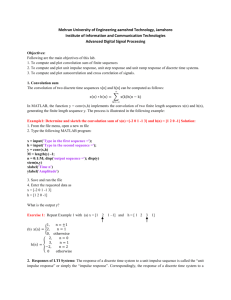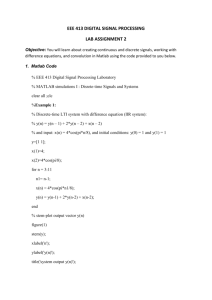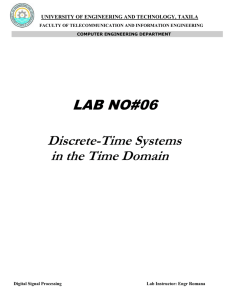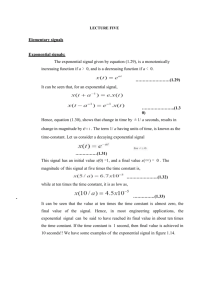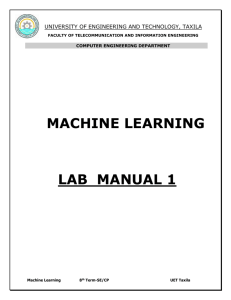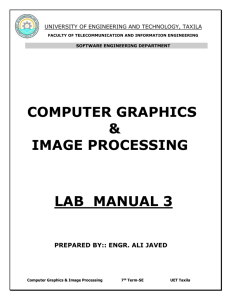View File - University of Engineering and Technology, Taxila
advertisement
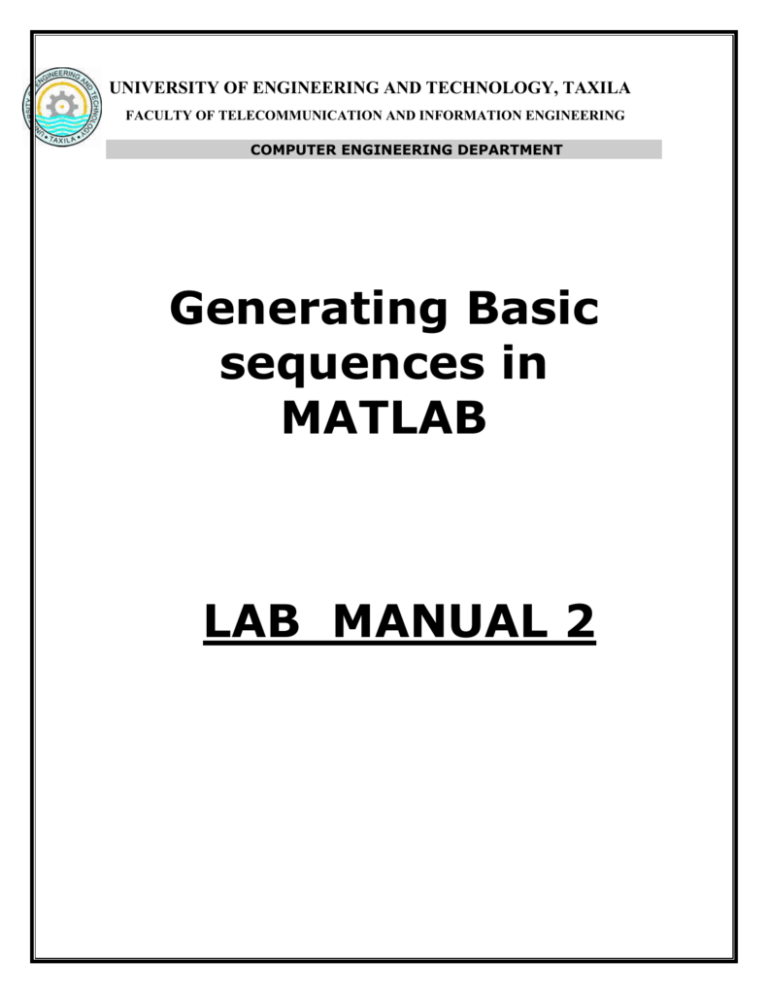
UNIVERSITY OF ENGINEERING AND TECHNOLOGY, TAXILA
FACULTY OF TELECOMMUNICATION AND INFORMATION ENGINEERING
COMPUTER ENGINEERING DEPARTMENT
Generating Basic
sequences in
MATLAB
LAB MANUAL 2
UNIVERSITY OF ENGINEERING AND TECHNOLOGY, TAXILA
FACULTY OF TELECOMMUNICATION AND INFORMATION ENGINEERING
COMPUTER ENGINEERING DEPARTMENT
Lab Objective: Generating basic sequences in MATLAB.
The tasks given in the lab include,
.
Generate Delta (Impulse) Function.
Generate Unit Step Function.
Generate Unit Ramp Function.
Generate Exponential Function
Generate sinusoidal function.
Generate unit impulse delay (shift) function.
Generate unit step delay (shift) function.
Generate unit ramp delay (shift) function.
Tool used: MATLAB
Lab Description:
The Unit Delta (Impulse) function: is often called the discrete time impulse or the unit
impulse. It is denoted by δ[n].
Discrete Shifted Unit Impulse:
Properties of Unit Impulse Function:
UNIVERSITY OF ENGINEERING AND TECHNOLOGY, TAXILA
FACULTY OF TELECOMMUNICATION AND INFORMATION ENGINEERING
COMPUTER ENGINEERING DEPARTMENT
Creation of Unit Impulse and Unit Step sequences:
A unit impulse sequence I[n] of length N can be generated using the MATLAB command
I= [1 zeros (1, N-1)];
A unit impulse sequence Id of length N delayed by d samples, where d<N, can be generated
using the MATLAB command
Id= [zeros (1, d) 1 zeros (1, N-d-1)];
Similarly, a unit step sequence S[n] of length N can be generated using the MATLAB
command
S= [ones (1, N)]
A delayed unit step sequence can be generated in a way similar to that used in the generation
of a delayed unit step sequence.
Program P1: can be used to generate and plot a unit impulse sequence between -5 and
10
%Generate a vector from -5 to 10
clf; %clear old graph
n= -5:10
%Generate the unit impulse sequence
I= [zeros (1, 5) 1 zeros (1, 10)];
%Plot the unit impulse sequence
stem (n,I);
title (‘Unit Impulse Sequence’)
xlabel (‘Time index n’);
ylabel (‘Amplitude’)
axis([-5 10 0 2])
UNIVERSITY OF ENGINEERING AND TECHNOLOGY, TAXILA
FACULTY OF TELECOMMUNICATION AND INFORMATION ENGINEERING
COMPUTER ENGINEERING DEPARTMENT
Task #1:
i. Modify the program P1 to generate a delayed and scaled unit impulse sequence Id[n] with a
delay of 7 samples and scaled by a factor of 3. Run the modified program and display the
sequence generated.
ii. Modify the program P1 to generate a unit step sequence S[n]. Run the modified program
and display the sequence generated.
iii. Modify the program P1 to generate a unit step sequence Sd[n] with an advance of 3
samples. Run the modified program and display the sequence generated.
The Unit step function: The unit step, denoted by u(n), is defined by
and is related to the unit sample by
The Unit Ramp Function:
UNIVERSITY OF ENGINEERING AND TECHNOLOGY, TAXILA
FACULTY OF TELECOMMUNICATION AND INFORMATION ENGINEERING
COMPUTER ENGINEERING DEPARTMENT
Task#2: Write a Matlab code that generates Unit Ramp function
The Exponential Function: Finally, an exponential sequence is defined by
Creation of Real Exponentials
Another basic discrete-time sequence is the exponential sequence. Such a sequence can be
generated using the MATLAB
UNIVERSITY OF ENGINEERING AND TECHNOLOGY, TAXILA
FACULTY OF TELECOMMUNICATION AND INFORMATION ENGINEERING
COMPUTER ENGINEERING DEPARTMENT
Program P2: given below can be used to generate a real-valued exponential sequence.
%Generation of a real exponential sequence
clf;
n=0:20;
a=2;
k=0.2;
x=k*a.^n;
stem(n,x);
title(‘Sinusoidal Sequence’);
xlabel(‘Time index n’);
ylabel(‘Amplitude’);
Task 3:
i. Which parameter controls the rate of growth or decay of this sequence and which parameter
controls the amplitude of this sequence? Run program P2 again with parameter ‘k’ changed
to 20.
ii. What will happen if the parameter a is less than 1? Run Program P2 again with parameter
‘a’ changed to 0.9.
Creation of Complex Exponentials:
Program P3: below can be used to generate a complex valued-exponential sequence.
%Generation of a complex exponential sequence
clf;
n=0:20
w=pi/6;
x=exp (j*w*n)
subplot(2,1,1);
stem(n,real(x));
xlabel(‘Time index n’);
ylabel(‘Amplitude’);
title(‘Real part’);
subplot (2,1,2);
stem (n,imag(x));
xlabel(‘Time index n’);
ylabel(‘Amplitude’);
title (‘Imaginary part’);
UNIVERSITY OF ENGINEERING AND TECHNOLOGY, TAXILA
FACULTY OF TELECOMMUNICATION AND INFORMATION ENGINEERING
COMPUTER ENGINEERING DEPARTMENT
Task#4:
a) Create x[n] = exp (j*n/3) for some range and see its real and imaginary parts separately
b) Make the following signals; plot their real and imaginary parts on the same figure. What
difference do you notice between the two signals?
The sinusoidal function:
Program P4: is a simple example that generates a sinusoidal signal
%Generation of a sinusoidal sequence
n=0:40; %length of sequence
f=0.1; %Frequency
phase = 0;
A=1.5; %Amplitude
x=A*cos (2*pi*f*n-phase);
stem(n,x);
title ('Sinusoidal Sequence')
xlabel ('Time index n');
ylabel ('Amplitude')
axis ([0 40 -2 2]);
grid;
UNIVERSITY OF ENGINEERING AND TECHNOLOGY, TAXILA
FACULTY OF TELECOMMUNICATION AND INFORMATION ENGINEERING
COMPUTER ENGINEERING DEPARTMENT
Task#5:
i. Modify the program P4 to generate a sinusoidal sequence of length 50, frequency 0.08,
amplitude 2.5 and phase shift 90 degrees and display it. Compare it with sequence of P4.
ii. Generate the following signals
Task# 6: Write a program in Matlab to generate Saw tooth Waveform.
Task# 7: Write a program in Matlab to generate a Triangular Pulse
Lab performed on (date): ___________ Reg #: ______________
Checked by: ________________________ Date: ______________
